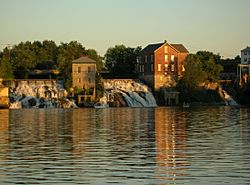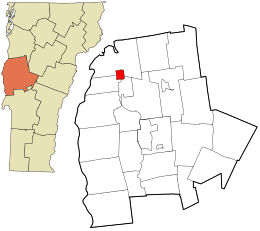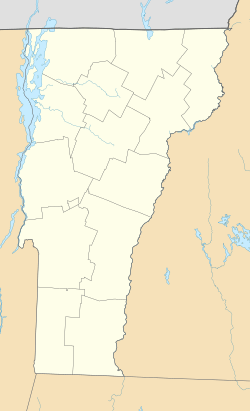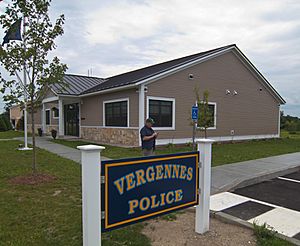Vergennes, Vermont facts for kids
Quick facts for kids
Vergennes, Vermont
|
||
|---|---|---|

Vergennes
|
||
|
||
| Nickname(s):
Little City on the Falls
|
||

Location in Addison County and the state of Vermont
|
||
| Country | United States | |
| State | Vermont | |
| County | Addison | |
| Incorporated as a city | 1788 | |
| Government | ||
| • Type | Council-manager | |
| Area | ||
| • Total | 2.55 sq mi (6.62 km2) | |
| • Land | 2.48 sq mi (6.42 km2) | |
| • Water | 0.08 sq mi (0.20 km2) | |
| Elevation | 194 ft (59 m) | |
| Population
(2020)
|
||
| • Total | 2,553 | |
| • Density | 1,001.2/sq mi (385.6/km2) | |
| Time zone | UTC−5 (Eastern (EST)) | |
| • Summer (DST) | UTC−4 (EDT) | |
| ZIP code |
05491
|
|
| Area code | 802 | |
| FIPS code | 50-74650 | |
| GNIS feature ID | 1460018 | |
| Website | www.vergennes.org | |
Vergennes is a small city in Addison County, Vermont, USA. It's surrounded by the towns of Ferrisburgh, Panton, and Waltham. In 2020, about 2,553 people lived there. Vergennes is the smallest city in Vermont by population. It was also the first city to be officially recognized in Vermont. It is the only city in Addison County.
Contents
History of Vergennes
Vergennes was first settled in 1766 by Donald MacIntosh. It became an official city in 1788. This was unique because it wasn't a town or village first. Instead, parts of the towns of New Haven, Panton, and Ferrisburg were combined. These areas met at the Otter Creek Falls.
Naming the City
The city is named after a French nobleman, Charles Gravier, comte de Vergennes. He helped the American colonists a lot during the American Revolutionary War.
Role in the War of 1812
During the War of 1812, important ships were built and prepared here. Thomas Macdonough led the effort to build a fleet. This fleet later defeated the British on Lake Champlain. The Monkton Iron Company, which was a very large iron factory, made parts for Macdonough's ships. They also made most of the cannonballs used by the United States Army in the north. The iron came from nearby Monkton. Ships like the USS Saratoga, USS Eagle, USS Ticonderoga, and USS Preble were part of this fleet. They were built or fixed up in Vergennes.
Growth and Changes
Leaders chose a city government early on. They hoped Vergennes would become a big industrial center. The Otter Creek Falls provided power for factories. Being close to Lake Champlain was great for moving goods. Industries grew in the late 1800s. Shipping through the Champlain Canal and wood-finishing were especially important.
However, railways started to take over from canals. This caused manufacturing in Vergennes to slow down. A railroad line built to the falls didn't work well because the hills were too steep. Businesses continued to decline in the 1900s. In the early 2000s, local groups worked to improve the downtown area. They also reconnected the city to its waterways. This brought more tourists, but rising rents made it hard for some businesses.
In July 2022, Vergennes got passenger train service again. Amtrak's Ethan Allen Express now stops at the Ferrisburgh–Vergennes station. The city had not had passenger trains since 1953.
Geography of Vergennes
Vergennes covers about 2.5 square miles (6.6 square kilometers). A small part of this area, about 0.1 square miles (0.2 square kilometers), is water.
Otter Creek flows north through the city. In the middle of Vergennes, there is a 37-foot (11-meter) waterfall. It has a large basin that sometimes floods.
Population of Vergennes
| Historical population | |||
|---|---|---|---|
| Census | Pop. | %± | |
| 1790 | 201 | — | |
| 1800 | 516 | 156.7% | |
| 1810 | 835 | 61.8% | |
| 1820 | 817 | −2.2% | |
| 1830 | 999 | 22.3% | |
| 1840 | 1,017 | 1.8% | |
| 1850 | 1,378 | 35.5% | |
| 1860 | 1,286 | −6.7% | |
| 1870 | 1,570 | 22.1% | |
| 1880 | 1,782 | 13.5% | |
| 1890 | 1,773 | −0.5% | |
| 1900 | 1,753 | −1.1% | |
| 1910 | 1,483 | −15.4% | |
| 1920 | 1,609 | 8.5% | |
| 1930 | 1,705 | 6.0% | |
| 1940 | 1,662 | −2.5% | |
| 1950 | 1,736 | 4.5% | |
| 1960 | 1,921 | 10.7% | |
| 1970 | 2,242 | 16.7% | |
| 1980 | 2,273 | 1.4% | |
| 1990 | 2,578 | 13.4% | |
| 2000 | 2,741 | 6.3% | |
| 2010 | 2,588 | −5.6% | |
| 2020 | 2,553 | −1.4% | |
| U.S. Decennial Census | |||
In 2010, there were 2,588 people living in Vergennes. There were 979 households and 632 families. The city had about 1,141 people per square mile.
About 92.8% of the people were White. About 3.0% were African American. Other groups made up smaller percentages. About 2.6% of the population was Hispanic or Latino.
About 34.3% of households had children under 18. About 48.8% were married couples. The average household had 2.47 people. The average family had 3.02 people.
The median age in the city was 33 years old. About 28.4% of the population was under 18. About 11.3% were 65 or older.
The median income for a household was $37,763. For a family, it was $48,155. About 17.0% of the population lived below the poverty line.
Economy and Jobs
Collins Aerospace is the biggest employer in Vergennes. This company has had different names over the years, including UTC Aerospace and BF Goodrich Aerospace.
Arts and Culture
Vergennes has the Vergennes Opera House. It hosts weekly events for the community. These events include local groups, bands, singers, and theater shows.
The city also has the Bixby Memorial Free Library. The library offers many activities. These include a book club, writing workshops, and story time for children.
Education in Vergennes
Vergennes has four schools:
- Vergennes Union Elementary School
- Vergennes Union High School
- Champlain Valley Christian School
- Northlands Job Corps Center
The Northlands Job Corps Center used to be called the Vermont Industrial School. It was later known as the Weeks School. It served as a home for orphans and young people in trouble until the late 1970s.
Transportation
Roads
Vermont Route 22A goes through the city. It connects with U.S. Highway 7 just north of Vergennes.
Train Service
Amtrak's Ethan Allen Express train stops at the Ferrisburgh–Vergennes station. This station is just north of the city. Other places you can reach by train from here include Burlington, Middlebury, Rutland, Albany, and New York City.
Notable People from Vergennes
Many interesting people have connections to Vergennes:
- Stephen Bates (1842–1907) was the sheriff of Vergennes for 25 years. He was the first Black sheriff in Vermont's history.
- Joseph K. Edgerton was a US congressman from Indiana.
- Frank L. Fish was a judge on the Vermont Supreme Court.
- Margaret Foley was a sculptor.
- Ethan A. Hitchcock was a US army officer and writer.
- Jeff Pidgeon is an American screenwriter, animator, and voice actor at Pixar.
- Samuel Strong was a military officer and a mayor of Vergennes.
See also
 In Spanish: Vergennes (Vermont) para niños
In Spanish: Vergennes (Vermont) para niños





